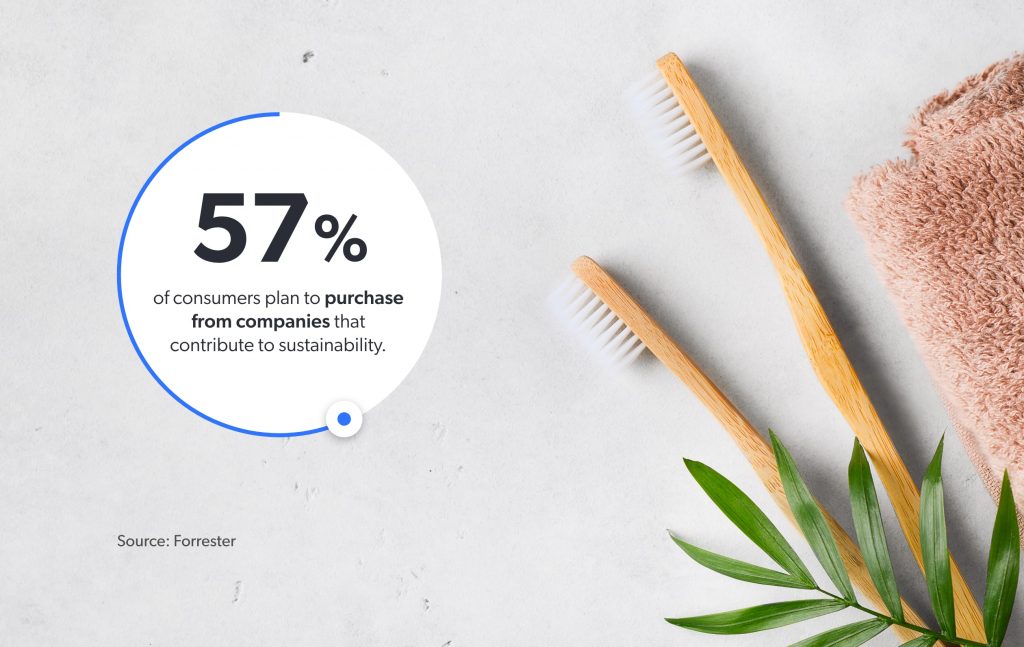By Miva | April 6, 2021

See why top ecommerce brands use Miva’s no-code platform to run
multiple stores, manage massive catalogs, and grow their revenue.
But what does sustainability in ecommerce actually entail? Does it mean that sellers need to completely change their operations or produce sustainable products? In this article, we discuss considerations for sustainability in ecommerce and how sellers can adapt to changing customer expectations while still remaining profitable.
Sustainability is a concept that focuses on meeting the needs of the present in a way that can sustain the needs of future generations. Think of sustainability as being comprised of three pillars: people, the environment, and the economy. Initiatives like reducing your carbon footprint, minimizing waste, and practicing fair trade are often associated with the concept of sustainability.
More than ever, shoppers consider a company’s commitment to sustainability as a deciding factor in whether they buy from that company. A survey from Forrester reveals that 57 percent of consumers intend to purchase from companies that contribute more often to sustainability. In an age when companies cannot expect customers to automatically return to their business, sustainable products and business practices help your business stand out, create customer loyalty, and appeal to conscious consumers.

Success in today’s sustainability-minded market is influenced by how well your business appeals to your audience and the things they really care about. Opinions about sustainability can vary across different generations—millennials are often known for prioritizing eco-friendly practices and Gen Z is even more willing to spend money on sustainable products.
Even if you’re not specifically targeting millennial or Gen Z shoppers, taking measures geared toward sustainability shows consumers that your business is more than just a place to buy products—it communicates that you’re a brand that stands for something and is worthy of their business. Your goal may be to find common viewpoints customers have about sustainability and adopt a sustainable ethos that appeals to them, keeps your business profitable, and makes a difference in the community.
Many businesses are leading the sustainability movement by adopting ethical production standards and using more environmentally-friendly materials. Because these standards and materials can sometimes drive up costs, it is not always realistic for every business to do the same while keeping prices down.
The good news is there are plenty of ways to make your business more sustainable without hurting your bottom line or alienating your customers. Here’s how:
The first place where you can introduce the concept of sustainability is through your brand. Your brand is how customers form an emotional connection with your company. By adopting sustainability as part of your branding, you’ll be able to communicate your philosophy, engage with customers, and establish a precedent across your entire business. Consider updating your company mission to include sustainable practices, creating an environmentally-focused campaign, or making donations to an organization that supports social well-being. 
Although fast shipping is a hallmark of modern ecommerce, it has a considerable carbon impact. You can lessen your environmental impact by offering slower shipping options (9 percent of shoppers select this option to support sustainable practices) and partnering with an eco-conscious shipping partner who can consolidate packages, ship items in bulk, or use compostable packaging materials. These are all ways to lower the amount of deliveries made and lessen the impact on the environment.
Packaging is a great place to make changes to your product offerings—up to 70 percent of consumers have indicated a willingness to pay more for sustainable packaging. Consider switching to recycled packaging materials or eliminating unnecessary and wasteful packaging.
Another impactful initiative is to add more sustainably-focused products to your catalog. You could update existing products to make them more eco-friendly or make changes to your supply chain to decrease the environmental footprint of your products. Marketing these products can help your business stand out on the market and meet your sustainability goals.
Educational content is a great way to get your audience on board with embracing sustainability. Email newsletters, blogs, and social media are channels where you can communicate with customers about your sustainability initiatives and share relevant news and content. This makes the concept of sustainability much more accessible to shoppers and raises awareness for those who might be not thinking about it.
One key way to lower your company’s carbon footprint is to reduce your return rate, which not only helps cut costs but also lessens the impact on the environment. While online shoppers love having the option of free returns, you can optimize your website to help minimize returns and decrease your carbon footprint. Consider leveraging detailed product descriptions, customer reviews, user-generated content, and online merchandising tools like visualizers and builders. These help shoppers know exactly what to expect from your products and have the information they need to make the right purchase the first time.
The sustainability movement continues to remain top of mind for both sellers and customers. Sustainable practices allow your business to appeal to what customers care about and contribute to the community, increasing your online presence and influence, and leading to your long-term success.
Download our guide for more ideas on making your ecommerce business more sustainable with real examples from other online stores.

Share this article:
No worries, download the PDF version now and enjoy your reading later...
Download PDF Miva
Miva
Miva offers a flexible and adaptable ecommerce platform that evolves with businesses and allows them to drive sales, maximize average order value, cut overhead costs, and increase revenue. Miva has been helping businesses realize their ecommerce potential for over 20 years and empowering retail, wholesale, and direct-to-consumer sellers across all industries to transform their business through ecommerce.
Visit Website